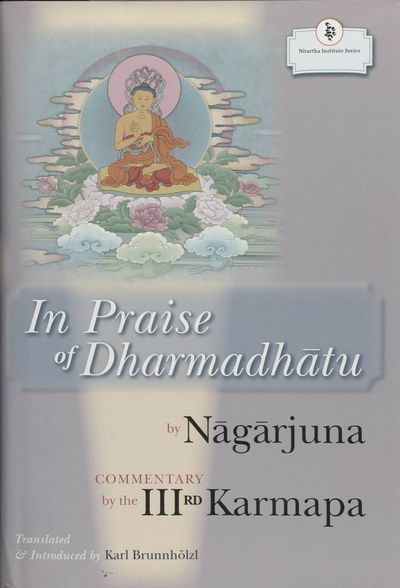- Abbreviations7
- An Aspiration by H.H. the Seventeenth Karmapa, Orgyen Trinlé Dorjé 9
- Foreword by H.H. the Seventeenth Karmapa, Orgyen Trinlé Dorjé 11
- Foreword by The Dzogchen Ponlop Rinpoche13
- Preface17
- Nāgārjuna and His Works21
- Who Was Nāgārjuna? 21
- What Did Nāgārjuna Write or Not Write? 22
- Various Views on Nāgārjuna's Scriptural Legacy and Its Scope 30
- Who or What Is Praised in Nāgārjuna's Praises? 43
- A Brief "History" of Luminous Mind57
- A Terminological Map for the Dharmadhātustava and Its Commentaries 57
- The Eight Consciousnesses 57
- The World Is Imagination 59
- Mind Has Three Natures 60
- A Fundamental Change of State 63
- The Expanse of the Basic Element of Being 63
- Self-Awareness and Personal Experience 64
- Having the Heart of a Tathāgata 66
- Luminous Mind 67
- Luminous Mind and Tathāgatagarbha68
- The Eighth Karmapa on the Dharmadhatu as "Disposition and Tathāgata Heart 83
- Is Buddha Nature an Eternal Soul or Sheer Emptiness? 102
- A Terminological Map for the Dharmadhātustava and Its Commentaries 57
- The Dharmadhātustava113
- An Overview of the Basic Themes of the Dharmadhātustava 113
- Translation: In Praise of Dharmadhatu 117
- The Significance of the Dharmadhātustava in the Indo-Tibetan Tradition 130
- The Third Karmapa, Rangjung Dorje, and His Commentary on the Dharmadhātustava 157
- A Short Biography 157
- Some Preliminary Remarks on Rangjung Dorje's View 159
- On Rangjung Dorje's Commentary on the Dharmadhātustava 193
- Other Tibetan Commentaries on the Dharmadhātustava 198
- Translation of Rangjung Dorjes Commentary206
- Appendix I: Outline of Rangjung Dorje's Commentary307
- Appendix II: Existing Translations of the Praises Attributed to Nāgārjuna in the Tengyur310
- Appendix III: Translations of the Remaining Praises313
- Glossary: English-Sanskrit-Tibetan Glossary325
- Glossary: Tibetan-Sanskrit-English Glossary329
- Bibliography333
- Endnotes344
- Index426
No edit summary |
No edit summary |
||
| Line 2: | Line 2: | ||
|BookParentPage=Library | |BookParentPage=Library | ||
|BookPerson={{Book-person | |BookPerson={{Book-person | ||
|PersonPage=Nāgārjuna | |||
|PersonName=Nāgārjuna | |||
}}{{Book-person | |||
|PersonPage=Brunnhölzl, K. | |PersonPage=Brunnhölzl, K. | ||
|PersonName=Karl Brunnhölzl | |PersonName=Karl Brunnhölzl | ||
| Line 7: | Line 10: | ||
|FullTextRead=No | |FullTextRead=No | ||
|TextTranslated=Texts/Dharmadhātustava | |TextTranslated=Texts/Dharmadhātustava | ||
|BookToc=* | |BookToc=* {{i|Abbreviations|7}} | ||
* | * {{i|An Aspiration by H.H. the Seventeenth Karmapa, Orgyen Trinlé Dorjé| 9}} | ||
*Foreword by H.H. the Seventeenth Karmapa, Orgyen Trinlé Dorjé 11 | * {{i|Foreword by H.H. the Seventeenth Karmapa, Orgyen Trinlé Dorjé |11}} | ||
*Foreword by The Dzogchen Ponlop Rinpoche 13 | * {{i|Foreword by The Dzogchen Ponlop Rinpoche|13}} | ||
* | * {{i|Preface|17}} | ||
* | *{{i|Nāgārjuna and His Works|21}} | ||
**Who Was Nāgārjuna? 21 | **{{i|Who Was Nāgārjuna? |21}} | ||
**What Did Nāgārjuna Write or Not Write? 22 | **{{i|What Did Nāgārjuna Write or Not Write? |22}} | ||
**Various Views on Nāgārjuna's Scriptural Legacy and Its Scope 30 | **{{i|Various Views on Nāgārjuna's Scriptural Legacy and Its Scope |30}} | ||
**Who or What Is Praised in Nāgārjuna's Praises? 43 | **{{i|Who or What Is Praised in Nāgārjuna's Praises? |43}} | ||
* | *{{i|A Brief "History" of Luminous Mind|57}} | ||
**A Terminological Map for the Dharmadhātustava and | **{{i|A Terminological Map for the Dharmadhātustava and Its Commentaries |57}} | ||
***{{i|The Eight Consciousnesses |57}} | |||
**The Eight Consciousnesses 57 | ***{{i|The World Is Imagination |59}} | ||
**The World Is Imagination 59 | ***{{i|Mind Has Three Natures |60}} | ||
**Mind Has Three Natures 60 | ***{{i|A Fundamental Change of State |63}} | ||
**A Fundamental Change of State 63 | ***{{i|The Expanse of the Basic Element of Being |63}} | ||
**The Expanse of the Basic Element of Being 63 | ***{{i|Self-Awareness and Personal Experience |64}} | ||
**Self-Awareness and Personal Experience 64 | ***{{i|Having the Heart of a Tathāgata |66}} | ||
**Having the Heart of a Tathāgata 66 | ***{{i|Luminous Mind |67}} | ||
**Luminous Mind 67 | **{{i|Luminous Mind and Tathāgatagarbha|68}} | ||
* | ***{{i|The Eighth Karmapa on the Dharmadhatu as "Disposition and Tathāgata Heart |83}} | ||
* | ***{{i|Is Buddha Nature an Eternal Soul or Sheer Emptiness? |102}} | ||
**The Eighth Karmapa on the Dharmadhatu as "Disposition and Tathāgata Heart 83 | *{{i|The Dharmadhātustava|113}} | ||
**Is Buddha Nature an Eternal Soul or Sheer Emptiness? 102 | **{{i|An Overview of the Basic Themes of the Dharmadhātustava |113}} | ||
* | **{{i|Translation: In Praise of Dharmadhatu |117}} | ||
**An Overview of the Basic Themes of the Dharmadhātustava 113 | **{{i|The Significance of the Dharmadhātustava in the Indo-Tibetan Tradition |130}} | ||
**Translation: In Praise of Dharmadhatu 117 | *{{i|The Third Karmapa, Rangjung Dorje, and His Commentary on the Dharmadhātustava |157}} | ||
**The Significance of the Dharmadhātustava in the Indo-Tibetan Tradition 130 | **{{i|A Short Biography 157}} | ||
* | **{{i|Some Preliminary Remarks on Rangjung Dorje's View |159}} | ||
**A Short Biography 157 | **{{i|On Rangjung Dorje's Commentary on the Dharmadhātustava |193}} | ||
**Some Preliminary Remarks on Rangjung Dorje's View 159 | **{{i|Other Tibetan Commentaries on the Dharmadhātustava |198}} | ||
**On Rangjung Dorje's Commentary on the Dharmadhātustava 193 | **{{i|Translation of Rangjung Dorjes Commentary|206}} | ||
**Other Tibetan Commentaries on the Dharmadhātustava 198 | *{{i|Appendix I: Outline of Rangjung Dorje's Commentary|307}} | ||
* | *{{i|Appendix II: Existing Translations of the Praises Attributed to Nāgārjuna in the Tengyur|310}} | ||
* | *{{i|Appendix III: Translations of the Remaining Praises|313}} | ||
* | *{{i|Glossary: English-Sanskrit-Tibetan Glossary|325}} | ||
* | *{{i|Glossary: Tibetan-Sanskrit-English Glossary|329}} | ||
* | *{{i|Bibliography|333}} | ||
* | *{{i|Endnotes|344}} | ||
* | *{{i|Index|426}} | ||
* | |||
* | |||
|AddRelatedTab=No | |AddRelatedTab=No | ||
}} | }} | ||
Revision as of 15:42, 25 July 2019
Nagarjuna is famous in the West for his works not only on Madhyamaka but his poetic collection of praises, headed by In Praise of Dharmadhatu. This book explores the scope, contents, and significance of Nagarjuna's scriptural legacy in India and Tibet, focusing primarily on the title work. The translation of Nagarjuna's hymn to Buddha nature—here called dharmadhatu—shows how buddha nature is temporarily obscured by adventitious stains in ordinary sentient beings, gradually uncovered through the path of bodhisattvas, and finally revealed in full bloom as buddhahood. These themes are explored at a deeper level through a Buddhist history of mind's luminous nature and a translation of the text's earliest and most extensive commentary by the Third Karmapa Rangjung Dorje (1284–1339), supplemented by relevant excerpts from all other available commentaries. The book also provides an overview of the Third Karmapa's basic outlook, based on seven of his major texts. He is widely renowned as one of the major proponents of the shentong (other-empty) view. However, as this book demonstrates, this often problematic and misunderstood label needs to be replaced by a more nuanced approach which acknowledges the Karmapa's very finely tuned synthesis of the two great traditions of Indian mahayana Buddhism, Madhyamaka and Yogacara. These two, his distinct positions on Buddha nature, and the transformation of consciousness into enlightened wisdom also serve as the fundamental view for the entire vajrayana as it is understood and practiced in the Kagyu tradition to the present day. (Source: Shambhala Publications)
| Citation | Brunnhölzl, Karl, trans. In Praise of Dharmadhātu: Nāgārjuna and the Third Karmapa, Rangjung Dorje. Nitartha Institute Series. Ithaca, NY: Snow Lion Publications, 2007. |
|---|---|
- Nāgārjuna. Dharmadhātustava (chos kyi dbyings su bstod pa), (D 1118) bstod tshogs, ka 63b5-67b3, Otani: (P2010), bstod tshogs, ka 73a7-77b8 (vol.46, p.31), (Tōh. 1118), ka 63b5-67b3. (N) ka 70a1-74b4. (Kinsha) 10, ka 90b1 (p.47-1-1) In bstan 'gyur (sde dge), Vol. 1: 126-134. Delhi: delhi karmapae choedhey, gyalwae sungrab partun khang, 1982-1985.

- rang byung rdo rje. dbu ma chos dbyings bstod pa'i rnam par bshad pa. In
- gsung 'bum rang byung rdo rje, Vol. 7: 1-125. Zi ling: mtshur phu mkhan po lo yag bkra shis, 2006.

- mdo sngags mtshams sbyor. Lan kru’u: kan su’u mi rigs dpe skrun khang, 2003: 219–321.

- mngon rtogs rgyan gyi sa bcad snang byed sgron me dang skabs brgyad kyi stong thun dang dbu ma chos dbyings bstod pa rnam bshad. Sarnath: Vajra Vidya Institute, 2004: 157–312.

- gsung 'bum rang byung rdo rje, Vol. 7: 1-125. Zi ling: mtshur phu mkhan po lo yag bkra shis, 2006.


